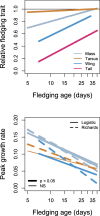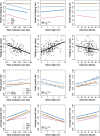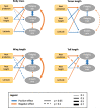Adaptation and constraint shape the evolution of growth patterns in passerine birds across the globe
- PMID: 33005206
- PMCID: PMC7526225
- DOI: 10.1186/s12983-020-00377-7
Adaptation and constraint shape the evolution of growth patterns in passerine birds across the globe
Abstract
Background: Growth trajectories should be adapted to selective factors of each species' environment. However, major shaping forces of growth and development are unclear, especially when studying several traits at once. Birds provide an ideal opportunity to analyze growth patterns across species due to there being enough available data. We tested the relative importance of nest predation risk, the number of care-givers, nest height, foraging substrate, clutch size, and latitude on growth patterns of passerine birds (Passeriformes) using phylogenetic comparative methods. Specifically, we studied the evolution of fledging time, average and peak growth rates, and relative development at fledging of body mass and tarsus, wing, and tail length.
Results: Using a comprehensive literature search and data quality control, we obtained data on growth in 231 species based on 295 populations. Species with long development in the nest grew slowly and had well-developed traits at fledging. Species breeding under high nest predation risk, building their nests close to the ground, and those living in northern temperate regions fledged early and grew fast, sometimes fledging with less developed body mass and traits critical for locomotion (tarsus, wing, and tail). On the other hand, the number of caring adults, clutch size, and species' foraging substrate had very limited predictive value for growth patterns across passerine species.
Conclusions: Shortening of the nestling period was a primary means of accelerating development (in relation to nest predation, nest height, and latitude), sometimes supplemented by higher peak growth rates of body mass, tarsus, and wing (especially in relation to latitude). Overall growth patterns of passerines were adaptively tuned to nest predation risk and nest height, with northern temperate species having especially short nestling periods and fast growth rates of body mass, tarsus, and wing.
Keywords: Birds; Development; Growth rate; Latitude; Life history; Nest predation.
© The Author(s) 2020.
Conflict of interest statement
Competing interestsThe authors declare that they have no competing interests.
Figures





Similar articles
-
Development syndromes in New World temperate and tropical songbirds.PLoS One. 2020 Aug 17;15(8):e0233627. doi: 10.1371/journal.pone.0233627. eCollection 2020. PLoS One. 2020. PMID: 32804928 Free PMC article.
-
Nest predation risk and growth strategies of passerine species: grow fast or develop traits to escape risk?Am Nat. 2012 Sep;180(3):285-95. doi: 10.1086/667214. Epub 2012 Jul 18. Am Nat. 2012. PMID: 22854072
-
Global drivers of variation in cup nest size in passerine birds.J Anim Ecol. 2023 Feb;92(2):338-351. doi: 10.1111/1365-2656.13815. Epub 2022 Oct 2. J Anim Ecol. 2023. PMID: 36134498 Free PMC article.
-
Predators and the breeding bird: behavioral and reproductive flexibility under the risk of predation.Biol Rev Camb Philos Soc. 2009 Aug;84(3):485-513. doi: 10.1111/j.1469-185X.2009.00085.x. Biol Rev Camb Philos Soc. 2009. PMID: 19659887 Review.
-
Predation on dependent offspring: a review of the consequences for mean expression and phenotypic plasticity in avian life history traits.Ann N Y Acad Sci. 2009 Jun;1168:201-17. doi: 10.1111/j.1749-6632.2009.04577.x. Ann N Y Acad Sci. 2009. PMID: 19566709 Review.
Cited by
-
Variations in the Reproductive Strategies of Different Charadrius alexandrinus Populations in Xinjiang, China.Animals (Basel). 2023 Jul 10;13(14):2260. doi: 10.3390/ani13142260. Animals (Basel). 2023. PMID: 37508039 Free PMC article.
-
Early-life patterns of growth are linked to levels of phenotypic trait covariance and postfledging mortality across avian species.Ecol Evol. 2021 Nov 5;11(22):15695-15707. doi: 10.1002/ece3.8231. eCollection 2021 Nov. Ecol Evol. 2021. PMID: 34824783 Free PMC article.
-
High-elevation birds grow more slowly but to heavier weights than low-elevation birds.Oecologia. 2025 Mar 7;207(3):50. doi: 10.1007/s00442-025-05685-5. Oecologia. 2025. PMID: 40050562
References
-
- Gilbert SF, Epel D. Ecological Developmental Biology. Sunderland: Sinauer Associates; 2008.
-
- Wainwright PC, Reilly SM. Ecological morphology: integrative organismal biology. Chicago: University of Chicago Press; 1994.
-
- Norberg UM. How a long tail and changes in mass and wing shape affect the cost for flight in animals. Funct Ecol. 1995;9:48–54. doi: 10.2307/2390089. - DOI
-
- Zeffer A, Johansson LC, Marmebro Å. Functional correlation between habitat use and leg morphology in birds (Aves) Biol J Linn Soc. 2003;79:461–484. doi: 10.1046/j.1095-8312.2003.00200.x. - DOI
LinkOut - more resources
Full Text Sources

